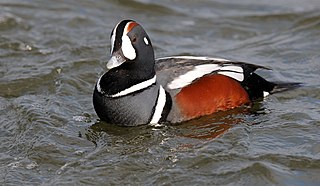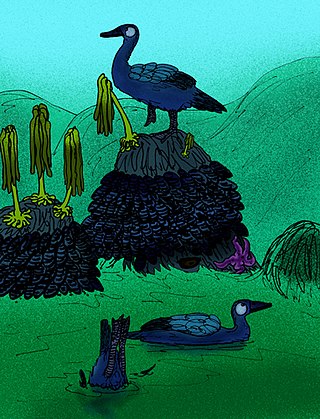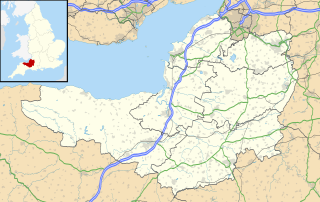
The seaducks (Mergini) are a tribe of the duck subfamily of birds, the Anatinae. The taxonomy of this group is incomplete. Some authorities separate the group as a subfamily, others remove some genera from the group and keep others. Most species within the group spend their winters near coastal waters. Many species have developed specialized salt glands to allow them to tolerate salt water but these are poorly developed in juveniles. Some of the species prefer riverine habitats. All but two of the 20 species in this group live in far northern latitudes.

Madridejos, officially the Municipality of Madridejos,, is a 4th class municipality in the province of Cebu, Philippines. According to the 2015 census, it has a population of 36,429 people.

Chendytes lawi, commonly called the Law's diving-goose, was a goose-sized flightless sea duck, once common on the California coast, California Channel Islands, and possibly southern Oregon. It lived in the Pleistocene and survived into the Holocene. It appears to have gone extinct at about 450–250 BCE. The youngest direct radiocarbon date from a Chendytes bone fragment dates to 770–400 BCE and was found in an archeological site in Ventura County. Its remains have been found in fossil deposits and in early coastal archeological sites. Archeological data from coastal California show a record of human exploitation of Chendytes lawi for at least 8,000 years. It was probably driven to extinction by hunting, animal predation, and loss of habitat. There is nothing in the North American archaeological record indicating a span of exploitation for any megafaunal genus remotely as long as that of Chendytes.

North Brewham Meadows is an 8.9 hectare biological Site of Special Scientific Interest at North Brewham in Somerset, England, notified in 1987.

Batu Lawi is a twin-peaked mountain in the Kelabit Highlands of Sarawak, Malaysia (Borneo) that has played important roles in both ancient mythology and modern history. The taller 'male' peak is 2046 metres above sea level, while the female summit is at 1850 metres. It is one of the highest mountains in the state of Sarawak.

Campomanesia phaea is a species of plant in the family Myrtaceae. The plant is endemic to the Atlantic Forest ecoregion in southeastern Brazil. It is found in the states of Paraná, Rio de Janeiro, São Paulo.
Gmina Malbork is a rural gmina in Malbork County, Pomeranian Voivodeship, in northern Poland. Its seat is in the town of Malbork, although the town is not part of the territory of the gmina. Malbork is also the administrative seat or capital of Malbork County.
Alak is a language spoken by some 4,000 people in southern Laos, especially in the Provinces of Salavan and Sekong. It is closely related to the language spoken by the Bahnars of Vietnam. It includes two dialects, Alak proper and Harak.
Burmese diaspora refers to citizens of Burma (Myanmar) who have moved abroad, regardless of ethnicity. Burma contains over 40 different ethnic groups, though the term "Burmese" can be used to refer to the Bamar ethnicity. Between 1.5 and 2 million Burmese nationals live in neighboring Thailand, the largest destination. Some half a million work in Malaysia. Many were minorities in Burma. Significant numbers also reside in Tokyo, Japan; followed by Singapore; Indonesia; Australia; India; the European Union and the United States.

The little woolly mouse opossum is a nocturnal, arboreal and mainly solitary South American marsupial of the family Didelphidae. It is native to the western slopes of the Andes in Colombia, Ecuador and Peru, where it lives at altitudes from sea level to 1500 m. It primarily inhabits lowland rainforest and montane cloud forest, although it has been reported from dry forest in the southern end of its range. It was formerly assigned to the genus Micoureus, which was made a subgenus of Marmosa in 2009. Its conservation status is Vulnerable, due to habitat fragmentation and continuing loss of habitat via urbanization and conversion to agriculture.

The Pulong Tau National Park is a national park in the Kelabit Highlands of Sarawak, Malaysia, on the island of Borneo.

Kantarawadi (Thai: กันตรวดี), also known as Gantarawadi, was one of the Karenni States in what is today Kayah State in Burma. It was also known as "Eastern Karenni" owing to the location of part of its territory east of the Salween River.

Heteropsis phaea is a butterfly in the family Nymphalidae. It is found in Angola, the Democratic Republic of the Congo, Uganda, Kenya, Tanzania and Zambia. The habitat consists of open Brachystegia woodland.
Lavi is a Mon–Khmer language of the Bahnaric branch spoken in Sekong Province, Laos. Chazée (1999:95) estimates the population at 500, while the 2015 Laotian census places the Lavi population at 1,215.

Tetraopini is a tribe of longhorn beetles in the subfamily Lamiinae.
Phaea is a genus of longhorn beetles of the subfamily Lamiinae, containing the following species:
Phaea maxima is a species of beetle in the family Cerambycidae. It was described by Henry Walter Bates in 1881. It is known from Mexico.
Phaea monostigma is a species of beetle in the family Cerambycidae. It was described by Haldeman in 1847, originally under the genus Oberea. It is known from the United States.

Lawi Lalang is a Kenyan-American runner who ran for the University of Arizona. Lawi Lalang was coached by James Li of the University of Arizona, who also coaches other eminent Kenyan-American runners including Bernard Lagat.
James Li is a Chinese-American athletics coach at the University of Arizona. His teams have won 12 national championships. He is known for his work with international runners, including from Kenya and Sudan. Successful runners he has coached include Stephen Sambu, Lawi Lalang. and Bernard Lagat. Li has been at Arizona for 15 years as of 2018. Before that he spent 13 years at Washington State University.














